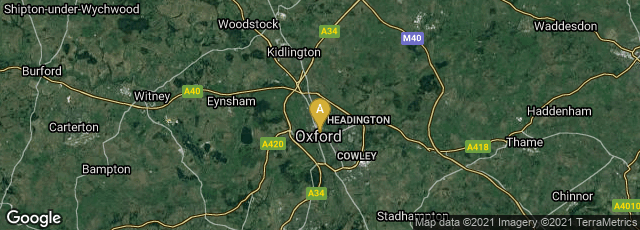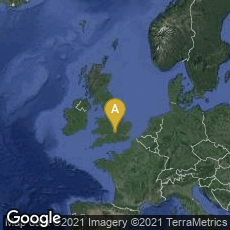

A: Oxford, England, United Kingdom
In 1697, the year of the death of English astronomer and scholar Edward Bernard, Catalogi librorum manuscriptorum Angliae et Hiberniae in unum collecti cum indice alphabeticum was issued from Oxford at the Sheldonian Theatre, in two folio volumes. Listing around 30,000 manuscripts, this was the first printed attempt at a union catalogue of manuscripts for a country—England, including Ireland, the conquest of which had been completed by the British in 1691. Centuries earlier in the Middle Ages union catalogues of manuscripts had been compiled in England. About 1320 Oxford Franciscans had compiled, on the basis of on-site surveys, the Registrum Anglie de libris doctorum et auctorum ueterum — a manuscript union catalogue of some 1400 manuscript books in England, Scotland and Wales, and around 1350 the Benedictine monk Henry of Kirkestede, prior of the royal abbey of St. Edmund at Bury St Edmunds in Suffolk—traditionally known as Boston Burienis, compiled a union catalogue of manuscripts in English libraries entitled Catalogus de libris autenticis et aposcrifis.
Bernard had worked on the catalogue for years when in 1692
"a movement started in Oxford to follow up the catalogue of printed books in Bodley with a catalogue of the manuscripts there and in college libraries. Dr. Edwards, Principal of Jesus, approached the curators of the Clarendon Press, who accepted the proposal. The scheme was enlarged to include the collections in Cambridge and in cathedral libraries and finally in private libraries. Cambridge kept aloof; only four colleges sent their catalogues, and the University Library and the remaining colleges were represented only by a reprint of the lists made by Thomas James in 1600. Bernard was in ill health and died on 12 January, 1697, while the book was still in the press" (Simpson, Proof-Reading in the Sixteenth, Seventeenth and Eighteenth Centuries [1970] 189, see also 190-94).
Though the printed catalogue identified Edward Bernard as the only author, it was actually a cooperative venture compiled by several scholars. Arthur Charlette, Master of University College, Oxford, seems to have been in charge of gathering information for the catalogue. However, the most significant contributor other than Bernard was probably the Harleian librarian, palaeographer and scholar of Old English Humpfrey Wanley. Wanley researched holdings of collectors in England whose libraries needed to be included, and was the author of four catalogues of holdings within the union catalogue: (1) the Free School at Coventry, (2) Basil Fielding, 4th Earl of Denbigh (3) St. Mary's Church, Warwick, and (4) John Ayres. Wanley also compiled the index to the entire work, wrote the Preface and corrected some of the proofs. References to Wanley's work on the catalogue appear in his letters. See Letters of Humfrey Wanley, Palaeographer, Anglo-Saxonist, Librarian, 1672-1726, Edited by P. L. Heyworth (1989).
The catalogue is notable for containing the holdings of numerous significant private collectors as well as institutional libraries. Among the better-remembered collectors whose manuscripts are recorded are Samuel Pepys, John Eveyn, William Laud, Thomas Bodley, John Leland, Roger Dodsworth, Richard James, Robert Huntington, and Antony Wood. The crucial holdings of Sir Robert Cotton were not included in Bernard's catalogue because just one year earlier Thomas Smith's Catalogus librorum manuscriptorum bibliothecae Cottonianae had been issued in identical format by the same printer. My copy of Bernard's catalogue was bound at the time with Smith's catalogue of the Cottonian library at the back of its second volume. It would appear that the two works were intended to supplement one another.